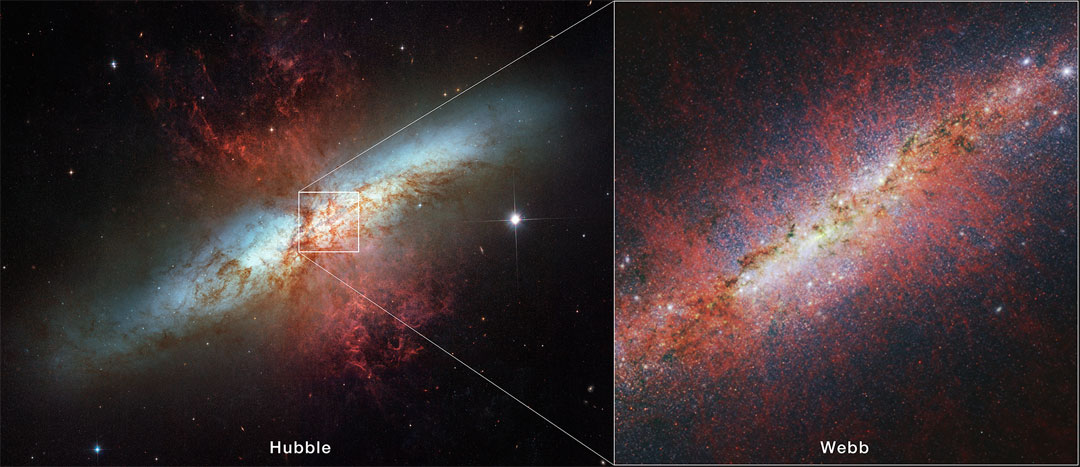Nombre total de pages vues
17/04/2024
SANTé/MEDECINE - HISTOIRE - 1967 : première transplantation cardiaque par Barnard
ASTRONOMY - Total Eclipse and Comets
2024 April 17
Image Credit & Copyright: Lin Zixuan (Tsinghua U.)
Explanation: Not one, but two comets appeared near the Sun during last week's total solar eclipse. The expected comet was Comet 12P/Pons-Brooks, but it was disappointingly dimmer than many had hoped. However, relatively unknown Comet SOHO-5008 also appeared in long duration camera exposures. This comet was the 5008th comet identified on images taken by ESA & NASA's Sun-orbiting SOHO spacecraft. Likely much smaller, Comet SOHO-5008 was a sungrazer which disintegrated within hours as it passed too near the Sun. The featured image is not only unusual for capturing two comets during an eclipse, but one of the rare times that a sungrazing comet has been photographed from the Earth's surface. Also visible in the image is the sprawling corona of our Sun and the planets Mercury (left) and Venus (right). Of these planets and comets, only Venus was easily visible to millions of people in the dark shadow of the Moon that crossed North America on April 8.
16/04/2024
INVENTEURS TUéS PAR LEURS CREATIONS - Donald Campbell
SANTé/MEDECINE - La complexité de la tête humaine - Anatomie de la face vue du côté
SANTé/MEDECINE - HISTOIRE - La lobotomie pratiquée jusque dans les années 1960
ASTRONOMY - Filaments of the Vela Supernova Remnant
2024 April 16
Image Credit: CTIO, NOIRLab, DOE, NSF, AURA; Processing: T. A. Rector (U. Alaska Anchorage), M. Zamani & D. de Martin (’s NOIRLab)
Explanation: The explosion is over, but the consequences continue. About eleven thousand years ago, a star in the constellation of Vela could be seen to explode, creating a strange point of light briefly visible to humans living near the beginning of recorded history. The outer layers of the star crashed into the interstellar medium, driving a shock wave that is still visible today. The featured image captures some of that filamentary and gigantic shock in visible light. As gas flies away from the detonated star, it decays and reacts with the interstellar medium, producing light in many different colors and energy bands. Remaining at the center of the Vela Supernova Remnant is a pulsar, a star as dense as nuclear matter that spins around more than ten times in a single second.
15/04/2024
SANTé/MEDECINE - La compléxité de la tête humaine - Anatomie de la tête et radiographie
SANTé/MEDECINE - Le corps humain vu de l'intérieur - L'échographie, une aide au diagnostic
SANTé/MEDECINE - 1953 : découverte de la structure de l'ADN en double hélice
ASTRONOMY -The Cigar Galaxy from Hubble and Webb
2024 April 15
Image Credit: NASA, ESA, CSA, STScI, Alberto Bolatto (UMD)
Explanation: Something strange happened to this galaxy, but what? Known as the Cigar Galaxy and cataloged as M82, red glowing gas and dust are being cast out from the center. Although this starburst galaxy was surely stirred up by a recent pass near its neighbor, large spiral galaxy M81, this doesn't fully explain the source of the red-glowing outwardly expanding gas and dust. Evidence indicates that this material is being driven out by the combined emerging particle winds of many stars, together creating a galactic superwind. In the featured images, a Hubble Space Telescope image in visible light is shown on the left, while a James Webb Space Telescope image of the central region in infrared light is shown on the right. Detailed inspection of the new Webb image shows, unexpectedly, that this red-glowing dust is associated with hot plasma. Research into the nature of this strange nearby galaxy will surely continue.
ASTRONOMY - Earth During a Powerful Solar Storm
2025 september 15 Earth During a Powerful Solar Storm Video Credit: NASA 's SVS , SWRC , CCMC , SWMF ; T. Bridgeman et al. Expla...
-
2022 September 26 All the Water on Planet Earth Illustration Credit: Jack Cook, Adam Nieman, Woods Hole Oceanographic Institution ; Data ...
-
2021 August 11 Mammatus Clouds over Saskatchewan Image Credit & Copyright: Michael F Johnston Explanation: When do cloud bottoms appe...









